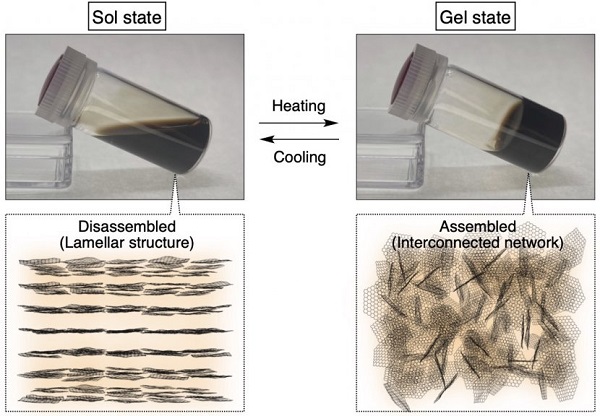Graphene-based two-dimensional materials have recently emerged as a focus of scientific exploration due to their exceptional structural, mechanical, electrical, optical, and thermal properties. Among them, nanosheets based on graphene-oxide (GO), an oxidized derivative of graphene, with ultrathin and extra wide dimensions and oxygen-rich surfaces are quite promising. Functional groups containing oxygen, such as carboxy and acidic hydroxy groups, generate dense negative charges, making GO nanosheets colloidally stable in water. As a result, they are valuable building blocks for next-generation functional soft materials.

GO nanosheets with tetrabutylammonium countercations undergo a sol–gel transition upon heating, moving from a disassembled lamellar structure to an assembled interconnected network. This technology can be harnessed as a direct writing ink for constructing three-dimensionally designable gel architectures.
In particular, thermoresponsive GO nanosheets have garnered much attention for their wide-ranging applications, from smart membranes and surfaces and recyclable systems to hydrogel actuators and biomedical platforms. However, the prevailing synthetic strategies for generating thermoresponsive behaviors entail modifying GO nanosheet surfaces with thermoresponsive polymers such as poly (N-isopropylacrylamide). This process is complex and has potential limitations in subsequent functionalization efforts.
To address this challenge, researchers led by Assistant Professor Koki Sano and Mr. Shoma Kondo from the Department of Chemistry and Materials at Shinshu University in Japan has recently presented an innovative approach called “countercation engineering” to impart the desired thermoresponsive ability to GO nanosheets themselves. Their work was made available online on 24 July 2023 and published in Volume 15, Issue 31 of the journal ACS Applied Materials & Interfaces on 9 August 2023.
Dr. Sano explains, “This study introduces a simplified and efficient route to achieving thermoresponsiveness by capitalizing on countercations (positively charged ions) inherently present in GO nanosheets. The control over these countercations offer a powerful tool for engineering stimuli-responsive nanomaterials.”
In their study, the researchers established a robust synthetic protocol involving a two-step reaction in water to synthesize GO nanosheets with specific countercations. An exchange reaction first replaced the countercations of the carboxy and acidic hydroxy groups with protons. This was followed by an acid–base reaction using a hydroxide anion with the target counteranions, resulting in the desirable GO nanosheets. Systematic investigations into their thermoresponsive behavior revealed that GO nanosheets harboring tetrabutylammonium (Bu4N+) countercations exhibited an inherent thermoresponsive nature in aqueous environments without requiring any thermoresponsive polymers.
Additionally, the researchers demonstrated a reversible sol−gel transition marked by self-assembly and disassembly processes. Upon heating, the lamellar Bu4N+-based GO nanosheets with electrostatic repulsion (sol state) between them reassembled to form an interconnected network dominated by van der Waals attraction (gel state) instead. This remarkable transition can, in fact, be harnessed to develop a direct writing ink for constructing three-dimensionally designable gel architectures of the GO nanosheets, pointed out the researchers.
Overall, the study’s findings have profound implications. “The controlled synthesis of GO nanosheets with tailored countercations has unveiled a pathway to versatile and simplified thermoresponsive materials. The thermoresponsive GO nanosheets are promising building blocks for biomedical, energy, and environmental applications, such as smart membranes, soft robotics, and recyclable systems, hydrogel actuators, and biomedical solutions,” highlights Dr. Sano. “Moreover, the ability to directly write with GO nanosheet dispersions offers a new dimension to material design, enabling the construction of intricate gel structures with ease,” he concludes.
It looks like “countercation engineering” could open doors to novel stimuli-responsive nanomaterials and even a new era in smart materials development!
Read the original article on Shinshu University.







